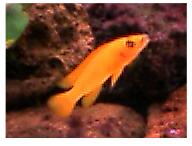|
|













| |
Lamprologus
Leleupi
Background:
This species was first discovered (and named) after an entomologist
called leleup working at the IRSAC station in Uvira, Zaire in 1958.
The Ornamental fish trade soon started collecting these fish from northern
Zaire whilst working in what was then called the Belgian congo. Unfortunately
the majority of fish collected from these parts lived in soft acidic
waters and it was presumed that L. Leleupi had similar requirements,
as a consequence, these highly expensive fish were kept in the purest
rainwater that aquarists could get their hands on. and the fish soon
died.
Now thankfully Every cichlid fancier knows, (or should know,) that these
fish thrive in the hard alkaline waters which are the norm. in Lake
Tanganyika.
Typical values are.
-
Ph
7.8 - 9.0
-
Total
hardness 11-17dh
-
Carbonate
Hardness 16-19
In the mid 1970s
a further subspecies was discovered by M. Fainzilber.
it was named L. Leleupi longoir in 1980 by Staeck.
L. lelupi longoir (meaning the longer leleupi) has only been discovered
along a rather short stretch of the east coast of Tanzania. and is easily
recognisable by its extended body length which is due to its higher
vertebral count.
Description:
L. leleupi is a rock dwelling cichlid with a bright yellow to orange
body and gorgeous light blue eyes which is rarely found above depths
of 40 meters.
Males of the species can attain a length of 4 inches whereas the females
stay slightly smaller at about 3-3.5 inches
Sexing the species is not an easy thing to do, males are larger and
quite often possess the cranial hump typical of cichlids, whereas the
forehead of the females is steeper. and she has a shorter pelvic fin.
Set-up:
Rockwork is a must when housing this cichlid, the more caves created,
the happier this fish will feel.
As already discussed Hard alkaline water is required to keep this fish
at its best, A base of coral sand and/or calciferous rocks such as limestone,
sandstone or tuffa rock will ensure that the ph and hardness do not
stray out of the recommended values, as any deviation will be detrimental
to the fishes health. possibly resulting in death.
Plants which can tolerate the water chemistry can be added to the tank
as this fish will not disturb them, recommended plants are Java fern,
Anubias nana and Certain vallis, although it must be stressed that plants
are very rare in the fishes natural habitat and of the 3 species mentioned
Vallis is the only native.
A tank of 2 foot is suitable for a breeding pair, but 4 foot plus is
recommended when keeping these fish as part of a community. Species
which can be kept with this fish are any of the smaller rockdwelling
cichlids, shelldwelling cichlids or (set up permitting) open water species.
Be careful of adding similar looking fish though as the Leleupi may
view them as a threat.
Also remember when stocking a Tanganyikan tank, the key is not to crowd
them in, provide your fish with ample swimming room and space for territory
and they will reward you thus.
Feeding:
Feeding the Leleupi is relatively simple. Being a micropredator it will
readily take anything small enough to fit in its mouth, foods such as
small shrimps, insect larvae and even snails are typical of its diet
in the wild. In the home aquarium it will quite readily adapt to flake,
pellet foods and frozen foods.
Breeding:
The fish forms pairs and after the initial courtship the female will
lay between 50 and 250 eggs on the roof of a cave, which she will then
guard, whilst the male does his duty protecting the greater territory,
when the fry hatch and are free swimming they can be fed a diet of Brine
shrimp naupali or crushed flakes, and as they grow, can be introduced
to more choice in their diet (pellets flake frozen etc.)
Notes:
I have a trio of these fish in a 260L tank (approx 57 gallons) they
share this tank with 3 Julidochromis, 2 Altolamprologus and 2 Synodontis.
They are a stunning fish and I find myself spending many hours with
my head up close to the glass watching them as they forage for food
amongst the rocks.
They do not appear to be overly aggressive amongst themselves or to
the other inhabitants of the aquarium which I attribute to the fact
that I have 3 females, (no male) extensive rockwork and low stocking
levels.
Charlie Hatcher
- charlhatch@aol.com
| |

